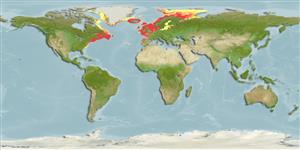分類 / Names
共通名の | 類義語 | Catalog of Fishes(部類, 種) | ITIS | CoL | WoRMS | Cloffa
>
Clupeiformes (Herrings) >
Clupeidae (Herrings, shads, sardines, menhadens)
Etymology: Clupea: Latin, clupea = sardine, derived from Clupeus = shield; doubtless a reference to the scales covering the body of the fish + Greek, odous = teeth (Ref. 45335).
More on author: Linnaeus.
Environment: milieu / climate zone / depth range / distribution range
生態学
海; 汽水性の 底生の漂泳性; 海洋回遊性 (Ref. 51243); 深さの範囲 0 - 364 m (Ref. 58426), usually 0 - 200 m (Ref. 6683). Temperate; 1°C - 18°C (Ref. 188); 80°N - 33°N, 95°W - 70°E
North Atlantic: in the west, it ranges from southwestern Greenland and Labrador southward to South Carolina, USA. In the east, it ranges from Iceland and southern Greenland southward to the northern Bay of Biscay and eastward to Spitsbergen and Novaya Zemlya in Russia, including the Baltic Sea (Ref. 188).
Length at first maturity / サイズ / 重さ / 年齢
Maturity: Lm 16.7 range ? - ? cm
Max length : 45.0 cm SL オス/雌雄の選別がない; (Ref. 37032); common length : 30.0 cm SL オス/雌雄の選別がない; (Ref. 37032); 最大公表体重: 1.1 kg (Ref. 6114); 最大記録サイズ: 25 年 (Ref. 89560)
背面の脊椎 (合計): 0; 背鰭 (合計): 13-21; 肛門の骨 0; 臀鰭: 12 - 23; 脊つい: 51 - 60. Slender fish with a round belly. Scutes without prominent keel; 12 to 16 post-pelvic scutes (Ref. 188). No median notch in upper jaw; operculum without radiating bony striae; the posterior border of its gill opening is evenly rounded. It is blue to greenish-blue dorsally, becoming silvery ventrally. No distinctive dark spots on the body or fins (Ref. 188).
Herring schools move between spawning and wintering grounds in coastal areas and feeding grounds in open water by following migration patterns learned from earlier year classes (Ref. 88171). Juveniles (up to 2 years) shoal close inshore, while adults are found more offshore (Ref. 6683). Adults spend the day in deeper water, but rise to shallower water at night (Ref. 89562). Light is an important factor in controlling their vertical distribution. A facultative zooplanktivorous filter-feeder, i.e., it can switch to filter-feeding if the food density and particle size are appropriate (Ref. 28664). Feed mainly on copepods finding food by visual sense. Herring schools often attract predators such as fish, birds, and marine mammals (Ref. 89563). Schooling, silvery sides, excellent hearing (capable of detecting frequencies between 30-4,000 Hz , Refs. 89391, 89564, 89566), and very fast escape response act as anti-predator devices (Ref. 28664). The most important races in the East Atlantic are the winter-spawning Norwegian and Icelandic herring, the autumn spawning Icelandic and North Sea herring and the Baltic Sea herring. Utilized fresh, dried or salted, smoked, canned and frozen; can be fried, broiled, microwaved and baked (Ref. 9988).
Life cycle and mating behavior
成熟 | 繁殖 | 放精 | 卵 | 生産力 | 幼生
The herring matures between 2-9 years (Refs. 35388, 82767, 89571). Herring populations are known to use traditional spawning grounds, many of which are along shallow coastal areas (15-40 m depth) or on offshore banks down to 200 m (Refs. 6684, 89572). Spawning usually occurs on gravel or rock bottoms, with the exception of Baltic populations which show a preference for shallow (less than 10 m depth) seaweed beds (Refs. 89520, 89572). Each population spawns only once a year over a relatively short time period (Ref. 89573). At least one population is spawning in any one month of the year, each having a different spawning time and place. The herring is a demersal spawner that releases a ribbon of sticky eggs that sink to the sea bed (Ref. 89574) and adhere to the substrate. The eggs released by a spawning population may be several layers thick which may deprive eggs in the bottom layers of oxygen, causing egg mortality (Ref. 89563). Although higher fecundities were reported earlier (e.g. Ref. 74523), fecundity now ranges from 10,000-60,000 eggs (Ref. 89571). Hatching may take up to 3 weeks, depending on temperature (Ref. 89571). Larvae are pelagic and drift with the current. Note: it is impossible to summarize briefly the wide range of spawning strategies of Atlantic herring; the best reviews are those of Svetovidov (Refs. 4608, 4609) for the Eastern Atlantic Ocean and Hildebrand (Ref. 4607) for the Western Atlantic Ocean.
Whitehead, P.J.P., 1985. FAO Species Catalogue. Vol. 7. Clupeoid fishes of the world (suborder Clupeoidei). An annotated and illustrated catalogue of the herrings, sardines, pilchards, sprats, shads, anchovies and wolf-herrings. FAO Fish. Synop. 125(7/1):1-303. Rome: FAO. (Ref. 188)
Human uses
水産業: 高い商業の; ゲームフィッシュ: はい
用具
特記事項
XMLをダウンロードして下さい
インターネットの情報源
Estimates based on models
Preferred temperature (Ref.
123201): 0.5 - 11.2, mean 6.6 °C (based on 912 cells).
Phylogenetic diversity index (Ref.
82804): PD
50 = 0.6250 [Uniqueness, from 0.5 = low to 2.0 = high].
Bayesian length-weight: a=0.00562 (0.00495 - 0.00638), b=3.09 (3.05 - 3.13), in cm total length, based on LWR estimates for this species (Ref.
93245).
栄養段階 (Ref.
69278): 3.4 ±0.1 se; based on diet studies.
Generation time: 3.3 (3.1 - 3.5) years. Estimated as median ln(3)/K based on 85
growth studies.
回復力 (Ref.
120179): 手段, 1.4年~4.4年の倍増期間の最小個体群 (rm=0.1-0.5; K=0.2-0.6; tm=2-5; tmax=25; Fec=17,300-301,000).
Prior r = 0.45, 95% CL = 0.30 - 0.68, Based on 40 stock assessments.
Fishing Vulnerability (Ref.
59153): Moderate vulnerability (41 of 100).
Climate Vulnerability (Ref.
125649): Low to moderate vulnerability (29 of 100).
Nutrients (Ref.
124155): Calcium = 75.4 [22.6, 182.8] mg/100g; Iron = 0.372 [0.199, 0.704] mg/100g; Protein = 17.5 [15.5, 19.5] %; Omega3 = 0.915 [0.561, 1.451] g/100g; Selenium = 16.5 [5.4, 49.4] μg/100g; VitaminA = 29.1 [6.6, 129.0] μg/100g; Zinc = 1.03 [0.58, 1.64] mg/100g (wet weight); based on
nutrient studies.
